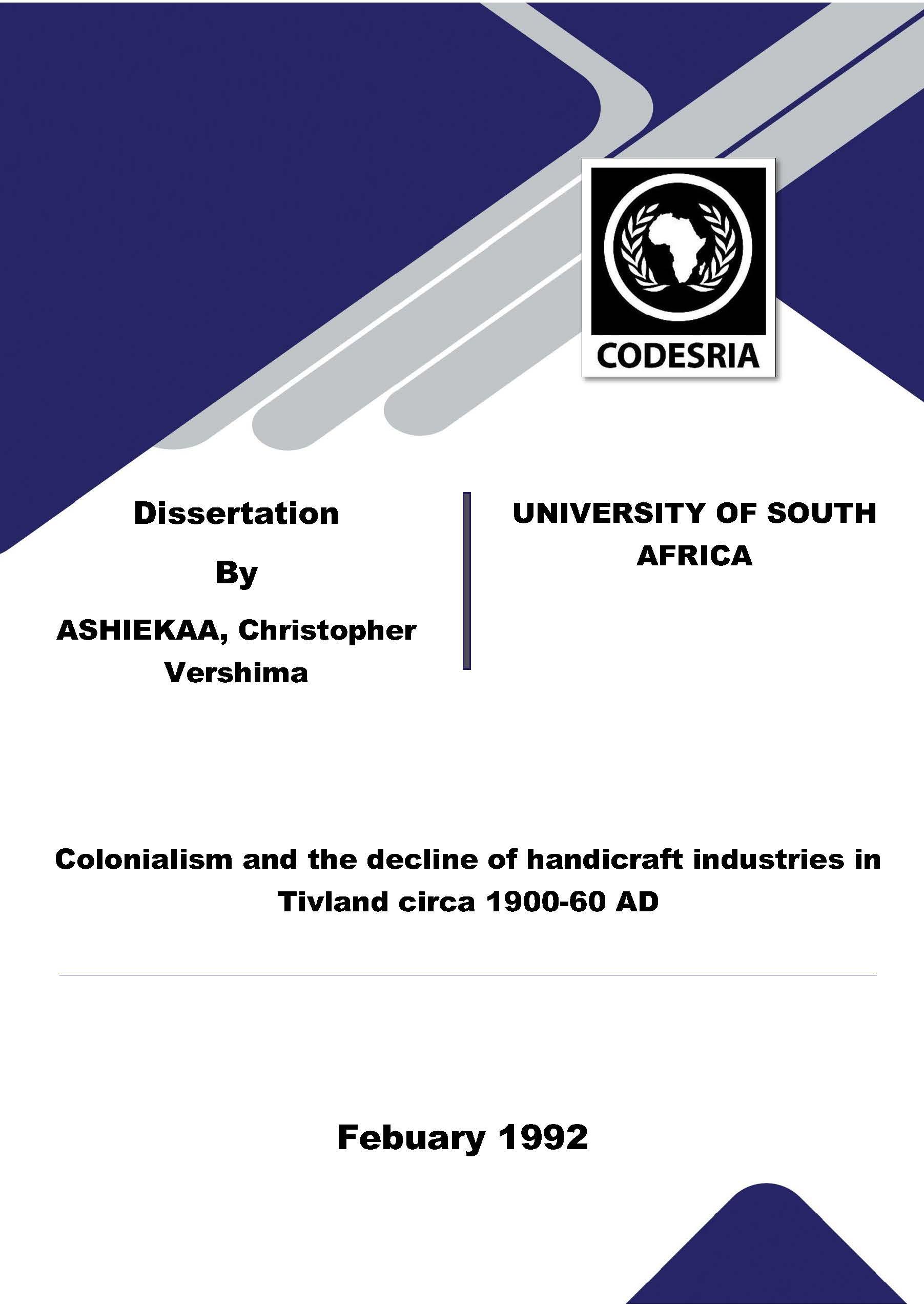LABOUR UNDER SAP: : A STUDY OF INDUSTRIAL RELATIONS IN THE UNIVERSITY'SUBSECTOR
Keywords:
Handicrafts, colonialism, industrial policy, industrialization, NigeriaSynopsis
The concem of this project is to assess the industrial relations situation in the Nigerian University subsector between 1986 (when StrilcturalAdjustmentProgramme (SAP) was introduced) and 1993. Theexercise was carried outby assessing the impact of SAP on living and working conditions and the reàction of trade unions within the sector.The research problematic was hinged on a realisation that although the Nigerian university system was never entirely crisis free, industrial crisis in the past was more orless anexception. Buttoday, theuniversity subsectoris enveloped inanunprecedented industrial crisis which has become
the norm. Considering the role of education and universities· in particular in the continuous reproduction of societal intellectual capacity and skills, it is of immense value to assess work relations in the subsector with a view to identifying how to eliminate antagonistic conflicts and attain a more harmonious industrial relations, from the point of view of the employees in the
subsector. An extensive review of existing literature was done on the origin and purpose of International Monètary Fund (IMF) and World Bank, the theoretical assumptions behilid SAP, the implementation of SAP and the social and political impacts of SAP. A theoretical framework for the study was also established by considering five early theories of trade unions and five contemporary the0ries ·of industrial relations. On basis of the literature review and theoretical framework, conclusions on
the value and meaning of the findings of the study were drawn. · A survey research method was adopted because of its capacity to study large population that cannot be directly observed. A sample size of 350 (three hundred and fifty) was selected out of an estimated study population of about 69000 (sixty-nine thousand) employees making up the three unions in the subsector- Academic Staff Union of Universities (ASUU); Senior Staff Association of University and Teaching Hospitals, Research Institutions and Associate Institutions (SSAUTHRIAI); and the Non-Academic Staff Union of Educational and Associated Institutions, (NASU). Stratified sampling technique was employed toensure that respondents eut across the three unions.
To pick the final respondents, purposive and double sampling techniques were adopted. On the whole, 249 questionnaires (representing 71% retum rate) were received from 21 universities out of about 30 universities in Nigeria. Three research instruments - questionnaire, content analysis and interview - were used to gather data. The data obtained were analysed using simple percentages, proportions, price indices, measures of central tendency, regression and correlation analysis. From the an.alysis of the data from all the research instruments used, the following findings were arrived at: 1. Adjusting basic salaries for inflation and converting basic salaries in the national currency (the naira) to their dollar($) equivalents, living standards of all categories of employees in the university subsector degenerated under SAP. There was a trend of a decline in the funding of the universities when the recurrent and capital budgetary allocations to Federal universities were converted into their dollar ($)
equivalents or adjusted for inflation, the practical effect of which was gross, inadequate and dilapidated facilities producing depressing working environment. The effect of the SAP policies of devaluation of the national currency (the naira) and cuts in
funding of education led to declaration of strike actions by all categories of unions (in the university subsector) among other industrial behaviours. The strikes that were called were in demand of improvements in wages and non-wage widerpolitical issues, including increase in wages, improvement in physical working conditions, adequate funding of the universities, university autonomy and democratisation of the administration of the universities, among others. Instead of labour overcoming the competition in the labour market in its reaction tothe effects of SAP, labour in the subsector actually took on the competitive character of the labour market environment as reflected in the divisive struggles for and against parity or unified conditions of service. By and large, SAP did not promote an environment in which the existence of unions could be
tolerated by university authorities and government. There was higher concentration of (national) strike activities between 1986 and 1993 (the SAP years) than previously in the university subsector. That although there was a relationship between the health of the economy and (strike) behaviour of the workers, the state of the health of the economy was not the only determinant for
strike actions. The main underlying causes of industrial crisis in the university subsector included non-implementation of collective agreements and absence of a democratic bargaining structure that could command the confidence and loyalty of ail parties. A more harmonious industrial relations could be attained in the university subsector on a programme of egalitarian society, unity of ail the unions, establishment of a democratic bargaining machinery, improved funding of universities and democratisation of· university administration, among others.
Downloads
References
ADESINA, J. "QuantitativeAlchemyandStrikeTrend in Nigeria", in Labour Relations ln Nigeria. Vol. 1,
Otobo, D., (ed.), Lagos: Malthouse Press Ltd., 1992.
African Business, No. 96, August 1986 ALUKO, S., West Africa, 7 May, 1973.
ALUKO, S., Business Champion, Vol. 2 No. 10, Nov. 1992 ALUKO, S., The Guardian, Friday, May, 7,
A MACHER, R.C., and ULBRICH, H.H., Principles of Macroeconomics. OHIO: South - Western Publishing
Co., 1986.
ASANTE,S.K.B.,African Development: Adebayo Adedeji'sAlternative Strategies. Ibadan: Spectrum Books
Ltd., 199i.
BOREHAM, P. and DOW. G. (eds.), Work and Inequality. Vol. 2.
BOTTOMORE, T.B. and MULKAY, M.J., (eds.), Controversies In Sociology. Vol. 5, London: George Allen
& Unwin Ltd., 1976.
BUDD, W.R., THORP, K.R., and DONOHEN, L., Content An lysis of
Communications. New York: The Macmillan Company, 1967.
Business Champion, Vol. 2, No. 10, Nov. 1992 DAMACHI, U.G., "Creating, Industrial Peace", NISER
Distinguished Guest Lecturer _July 1984; reprinted in Dan1achi, U.G.& Fashoyin, R.(eds.),
Contemporary Problems in Nigeria lndust.rial Relations. Lagos: Development Press, 1986.
Business International Limited, Report No. 2114, 1992.
Daily Times, 12 Nov. 1992.
DUNLOP, J.T., lndustrial Relations Systems. Carbondale: Southern Illinois University Press, 1958.
FARNHAM, D. and PIMLOTT, J., Understanding Industrial Relations. Cassen Education Limited, 1990.






